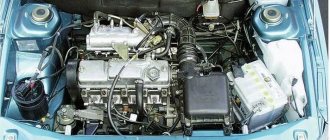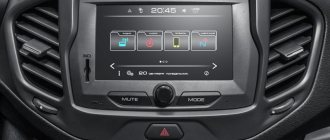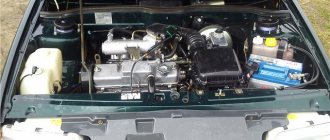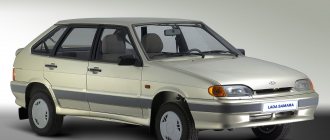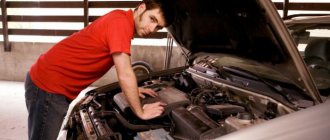— jerk
— short-term spontaneous change in engine speed regardless of the position of the gas pedal.
In everyday use, as a rule, there are a series of jerks; — failure
— a noticeable delay in the engine’s response to pressing the gas pedal. Approximately can be considered as a limiting case of a jerk.
Conventionally, three types of jerks can be distinguished:
- at the moment of starting movement; — during acceleration; — with steady motion, i.e. with the gas pedal in constant position.
When using the DAAZ Solex carburetor, a very unpleasant defect occurs: when you press the gas pedal, a strong dip occurs, the engine stalls, and often there is no idle speed. Movement is only possible when the gas pedal is pressed to the floor, or you have to continuously “pump” the pedal. The reason is clogging of the fuel nozzle of the main metering system of the first chamber.
For an experienced car enthusiast
it is necessary to remove the top cover of the carburetor, as described above, unscrew the two air jets, use a thin screwdriver to unscrew the two fuel jets and remove them from the wells with a long wooden toothpick or a pointed stick.
Do not mix up the jets when reinstalling them!
Then, use a syringe or a clean, lint-free cloth to remove gasoline from the float chamber and blow out the carburetor with compressed air, especially carefully - the fuel nozzle wells.
For an inexperienced car enthusiast
It is better to immediately contact a car service center. To get to the service center, cut off a piece of vinyl chloride tube 1–1.5 cm long (at least from the windshield washer tubes) and place it on the thrust lever of the second chamber drive. The engine speed will be approximately 2000 rpm. Use the clutch and brake pedals to maintain a safe speed.
Jerking when starting to move
At the moment the movement begins, the limiting case of a jerk—failure—occurs more often. The most unpleasant sensations are associated precisely with the delay in the engine’s response to pressing the gas pedal. Sometimes the engine even stalls.
The cause of failure may be either a malfunction of the carburetor accelerator pump or a malfunction of the vacuum corrector of the ignition distributor.
For work you need: wrenches “8” and “10”, Phillips and slotted screwdrivers, a clean rag, a piece of thin copper wire without insulation with a diameter of less than 0.3 mm, a compressor, a can of WD40 type liquid, possibly a portable lamp.
| EXECUTION ORDER |
1.
Remove the air filter housing cover by unscrewing the nut with a “10” wrench and unfastening the spring clips.
Remove the air filter. Unscrew the four nuts with a key “8”, use a screwdriver to loosen the clamp of the crankcase ventilation hose at the connection point to the valve cover and remove the air filter housing.
2.
Disconnect the vacuum corrector drive hose for the ignition distributor and, creating a vacuum with your mouth, check for leaks.
Does air flow freely?
No: see point 4
3.
Contact a car service to replace the vacuum corrector of the ignition distributor.
4.
Look inside the carburetor. The air damper must be fully open. Press down on the throttle lever. Streams of fuel should appear from both accelerator pump nozzle tubes. The streams should be even and directed into the gap between the diffuser wall and the opening damper. If necessary, use a portable lamp.
Is the fuel spray direction correct?
No: see point 6
5.
Contact a car service for diagnostics.
6.
Avoiding fuel spillage, remove the fuel supply hose to the carburetor and the fuel drain hose. Remove the choke control cable and wire from the idle air solenoid valve. Remove the five screws securing the carburetor top cover.
The car is shaking, what should I do?
At the first stage, the machine is diagnosed. Let's say that you have a Niva with a carburetor engine in your garage. Your car already shows signs of “illness” at the first stage of movement. Or the car started moving without any hassle, but when a certain number of revolutions was reached, the engine malfunctioned. All this will not give answers, but only creates questions, because anything can break. In any case, if unstable operation of the car’s power unit is noticed while pressing the accelerator pedal, the first thing you should do is:
- Check air and fuel filters. The supply of air and fuel to form a combustible mixture will be difficult if these elements are heavily contaminated.
- Check the fuel pump. Its incorrect operation leads to unstable fuel supply.
- Check fuel pressure. The supply of the fuel-air mixture under insufficient pressure often leads to jerking of the car. The pressure when the engine is running should not exceed 3 kgf/cm2.
Most of the reasons lie in the car's fuel system.
At the start
At the very beginning of the movement, such problems can begin, and here they will be the biggest jerks.
That is, the engine seems to be late in responding to the pressed gas pedal. It may even stall completely, this will happen if the control unit gives a signal to the throttle valve to open. And there are reasons for this:
- The fuel pump is running low and it begins to hum or make noise. It is necessary to listen to the engine on the injector before starting; it cannot be heard when the engine is running, since it is located in the fuel tank. On the carburetor, the pump is located under the hood, so it can be heard even when the engine is running.
- There is a special mesh on the fuel pump that periodically gets clogged, in which case you need to flush the gas tank or change this mesh.
- The fuel filter needs to be changed, also after a certain period of time.
- The pressure regulator may fail; it is located in the fuel pump; it is disassembled and the regulator is replaced.
Of course, at the very beginning it is worth checking the pressure in the fuel supply system; a pressure gauge is used for this. It must be connected to the fitting on the fuel system and watch the indicators of the device. Full readings cannot be shown, as they will be different on different engines. One thing we can say is that readings above one are not very good. The dynamics of the device readings can be found in the car manual; it states what the readings should be during normal operation of the car.
But the readings can be too high and here you can immediately answer that the reason for this is the pressure regulator, but it is better to replace it immediately; repairs are not practical here.
We eliminate jerks when the car starts moving
According to the number of reviews from owners of a Chevrolet Niva with a carburetor engine, it is the engine power system that most often poses a problem. Due to the breakdown of absolutely any element of the system, the stable process of fuel combustion in the cylinders can be disrupted. If an insufficient amount of mixture enters the cylinders, then the car in such conditions will not be able to produce the required power. Against the background of this problem, twitching will begin to appear.
Check the pipes, determine if there is any depressurization of the system. Measure the fuel pressure. If the indicator does not correspond to the norm, then further search for the cause should be sought in the pressure regulator, fuel pump. These actions must be performed not only with the carburetor system, but also with the injection system. If an injector is installed on the Niva 21214, then in this version the ignition system is also connected. The cause of the car jerking can be absolutely any sensor that has failed. Perhaps in this case you will need the help of specialists, because all the work is complicated by the presence of an electronic unit.
Diagnostics using ODB-2 scanner
Content
Since there are many reasons for the malfunction, first of all it is worth carrying out a comprehensive diagnosis of the car. This can be done most quickly using an ODB2 scanner.
Scan Tool Pro Black Edition
A special feature of Scan Tool Pro is the diagnosis of not only the engine, but also other vehicle components (gearbox, transmission, abs, etc.). After reading the errors, you will most likely know exactly the cause of the malfunction (problem in the pump, pressure regulator, lean fuel mixture, malfunction of one of the sensors), after which you should first pay attention to this element. The scanner is compatible with most models of the domestic automobile industry since 1993 and is designed specifically for the CIS - error codes with their interpretation are displayed in Russian.
Eliminate jerking when accelerating a car
If the Niva 21214 begins to twitch when accelerating, then in this case it is necessary to carefully check the engine power system. The driver presses the speed pedal while driving, but the vehicle does not accelerate. By pressing the accelerator pedal, the driver provokes an increase in the amount of fuel mixture supplied to the cylinders. If this does not happen, breakdowns occur in a uniform manner.
We check all filters: fuel, air. A carburetor engine has 2-3 filters. We will not take into account the mesh in the neck, since it can only prevent the penetration of large particles. You should carefully check the filter that goes to the fuel pump. Often it becomes clogged with impurities, which ultimately prevents the free flow of fuel, causing the engine to starve.
While driving
It is also an unpleasant situation when the car has jerks and dips during acceleration. This can happen both when driving and when starting off. A particularly unpleasant, or even dangerous, situation can arise while driving, for example, when a car is about to overtake, and then there is a sudden failure.
The causes of jerks during acceleration can be both those already mentioned and slightly different ones:
- If you have a carbureted car that jerks when accelerating, this may indicate that the ignition is too early. You need to set the lead angle. And checking the ignition timing is quite simple: at speed 4, accelerate to 50 km/h and brake sharply. If detonation lasts 1-2 seconds, then the ignition is set perfectly, the reason is not there;
- on “injectors” everything is controlled electronically. There, the jerking while driving and during acceleration may be due to the mixture being too lean. But this should be shown by diagnostics in the service. If the sensors “know about this, but are silent,” then it is quite possible that they themselves are faulty and must be replaced.
Eliminate jerking when the car is moving steadily
If a Chevrolet Niva or Niva 21214 exhibits twitching during stable movement, this most often happens due to problems with the ignition system. You can often hear car owners complaining that they just installed new spark plugs, but the engine has already failed. Detonation can occur even with new spark plugs due to incompatibility with the engine. If the spark plug fails, then the fuel will not burn completely, and breakdowns will begin in the operation of the power unit.
Checking the spark plugs is quite easy. The first thing you need to do is:
- Check the level of gaps on the unscrewed spark plugs. Check for any irregularities in the sparking process.
- A working spark plug produces a dark blue spark.
- If there is black carbon on the spark plug, then the problem may lie in a faulty ignition or faulty mixture formation.
If checking the spark plugs does not bring any results, you should check all wiring for oxidation and breakdowns. Don't forget about the coil and toggle switch. All elements of the ignition system, as in the case of a problem in the power system, are thoroughly inspected and checked for correct operation.
Why does the car jerk when you press the gas pedal?
Most car enthusiasts are faced with the problem of engine jolts during smooth or sudden acceleration. This problem is not critical and can be easily repaired. Moreover, users of both domestic VAZ 2112 with a 16-cl unit and owners of foreign cars such as Hyundai Solaris are not insured against this. If the car jerks when you press the gas pedal, you need to investigate such units.
So, you need to figure out what to do when the car starts to jerk during acceleration.
Transmission problems
Uneven running is also caused by transmission problems. Aggressive vehicle operation and neglect of maintenance will lead to jerking when starting the car. If there are no heavy loads and the driver treats the car with care, the risk of malfunctions is reduced many times over.
If a car with a manual transmission jerks at low speeds, the gearbox and all its parts have nothing to do with it. If the manual transmission breaks down, the car will not move. The problem may occur due to damage to the clutch mechanism. A worn or sticking driven disc is what causes your vehicle to jerk when changing gears.
The proper operation of an automatic transmission is largely determined by the quality and quantity of lubricant. Jerking is observed more often due to a lack of oil or the presence of foam. It is recommended to regularly check the lubricant level with a dipstick and not skimp on quality.
Communities VAZ Repair and Modification Blog 12shka twitches standard treatment or unexpected reasons
Replacing the cylinder head gasket of a VAZ-2112 16 valves with your own hands
Hi all. I decided to share a couple of observations in solving this problem. Quite recently on a community forum I asked the following question: the VAZ 2112 1.5 16v began to twitch at low speeds. 1-2 plugs and then picks up speed. Getting started was a real problem. The trouble did not arise abruptly. During the winter she came out and left from time to time. Over the last 2 weeks it has become constant. Plus, dullness of acceleration at medium speeds was added and, as a result, consumption was a plus. In general, the decision was made to replace the fuel filter. Well, I decided that there was no point in carrying out a replacement without inspecting the fuel pump and the mesh on it. According to the ABC book, I relieved the pressure in the system by removing the pump terminal and starting the car, and then took out the pump.
In general, after that I replaced the filter which, for obvious reasons, was up to its ears in dirt. I noticed an interesting nuance here. Before starting work, when I started the car to relieve pressure in the system, the car worked for at most 10 seconds, then I turned it purely with the starter as written in the book. The second time I had to release the pressure when a new filter and mesh were already in place. (The tube on the filter was leaking) So the second time the machine worked for 40 seconds! It responded perfectly to the gas pedal. Even when in doubt, I checked whether the pump terminal was disconnected. After that, it started up three more times and ran for about 10 seconds. And even after that, there was a little pressure left in the system. In general, this is how you can check the condition of the filter
If a car without a terminal on the pump stalls quickly, then you need to pay attention to the filter and the fuel pump. In short, I collected everything, drove it for a drive, the car became faster, but the failure did not go away. With the car running, if you jerked the throttle valve sharply, the engine seemed to choke at first and only then picked up speed
I checked all the sensors, cleaned the brain terminal, checked the air filter. Well, I decided to try changing the spark plugs. I started to remove the wires from them and I was confused that on the old wires, when I put them on and took them off, I could clearly hear the ringing click of the contact being put on. Nothing like this was heard on the new wires. I decided to test a stupid idea and threw in an old set of high-voltage wires and... everything disappeared! The engine began to respond instantly to the throttle and began to run smoother at idle. I was very surprised, I didn’t think that there could be a failure in any section of the gas. I would never have thought of them. To check, I installed new wires and the failure appeared again. After 2 days of driving, I clearly felt the return of traction at low speeds and the absence of failure at medium speeds, and no failures. In general, this is such a mysticism. I decided to share the information with you, maybe it will be useful for someone.Z, Y. I worked in the rain and was not in the mood to take pictures at all. Therefore, for clarity, I dug up photos on the net.
Z.Y.Y. I completely forgot! Don't forget to relieve pressure in the system! There are 2.5 kilograms! With such pressure, a gasoline shower is provided for the entire cabin. and even after resetting, I would advise unscrewing the filter tubes with glasses. The residual pressure just splashes into your eyes. Throw on any old glasses and you will look stylish in the process and your eyes won’t get hurt :):):):)…like mine
Malfunction of the incoming air mass flow sensor
The sensor for normal engine operation is the mass air flow sensor. In good condition, the device reads how much air enters the motor, sending information to the control unit. The “brains” calculate how much fuel injection is required for operation.
When the incoming air mass flow sensor is faulty, the car jerks at the slightest pressure on the gas. Fuel consumption increases. Testing the device is possible with a multimeter, which may make mistakes. It is recommended to go for diagnostics.
It is necessary to check the corrugation from the filter to the motor. If there is a crack, the part must be replaced. Air will enter through the hole into the motor, which does not “see” the mass air flow sensor. The electronic control unit will begin to receive incorrect data.
Accelerator
The gas pedal controls the flow of air into the intake manifold either through the throttle body for fuel injection or through the carburetor. The air is mixed with fuel supplied by the rail and injectors or carburetor, then ignited by spark plugs. The combustion of the working mixture in the cylinders causes the pistons to move up and down, rotating the crankshaft. When the gas pedal is closer to the floor, more air enters the intake manifold and mixes with a significant amount of fuel to turn the crankshaft faster.
If the motor output shaft is not connected to anything, it will rotate idle and make noise. When the gearbox comes into play, the torque from the engine is transmitted to the wheels.
Between the engine and transmission there is a clutch for manual transmissions or a torque converter for automatic transmissions. The clutch engages the engine from the transmission, and the torque converter maintains the connection but uses a single-sided fluid-fed stator and turbine to ensure the engine does not stall when idling.
At the end of the transmission is the output shaft for turning the driveshaft and wheels. Gears increase the torque on the output shaft. Each has a different diameter to increase torque but decrease output speed, and vice versa.
The drive wheels are connected through a differential, due to which the vehicle turns smoothly, although the left and right wheels cover different distances. The differential consists of a drive gear (rotated by the transmission output shaft) and a ring gear, gears that allow different rotation speeds, and two side gears directly connected to the axle shafts that turn the wheels. The differential rotates the direction of power flow by 90° to rotate the left and right wheels. The ring gear acts as the main gear to reduce speed and increase torque. The higher this ratio, the lower the maximum output speed of the axle (wheel) shafts, but the greater the increase in torque.
If the throttle position sensor is faulty, the engine speed will not be controlled by the accelerator pedal, but will increase or decrease regardless of whether the gas pedal is depressed or not.
The main cause of jerking is most often related to the supply of air to the fuel mixture. Due to lack of air, the crankshaft still rotates, although the pedal is no longer under load. Pressing the pedal sharply causes the vehicle to jerk and spin. The reason lies in the incorrect composition of the mixture.
When the power unit operates jerkily in carburetor cars, even with slight pressure on the gas pedal, the camera is checked. The outlet holes in the first carburetor chamber may be clogged. It is necessary to blow out the carburetor pipes and jets with compressed air.
During acceleration, the car may twitch while accelerating smoothly. This indicates an intermittent fuel supply to the carburetor float chamber. The gasoline pump does not have time to pump new portions of fuel. If this unit is not to blame, the reason is the “triple” of the engine. Perhaps only one of the four cylinders is functioning properly, and the engine is not able to respond in a timely manner to pressing the gas pedal. A full diagnosis is required.
Idling
A common phenomenon is floating idle speed when operating on gas; this occurs quite often after a recent change of injectors in the LPG system. And the fact that after replacing the injectors with new ones the car drove well for some time only confirms that this is precisely the problem. Or more precisely, the need for additional calibration of new injectors after the car has driven one to two thousand kilometers. If your problem is the unstable operation of the car at idle, after recently replacing the injectors, be sure to contact a specialist who will calibrate and configure the system.
conclusions
Eliminating the cause of the twitching of the 16-valve VAZ-2112 during acceleration is quite difficult. Many car enthusiasts are unable to fix the problem and immediately turn to a car service center. The article discussed the main methods for troubleshooting, but there are times when the cause lies in the most unexpected place. So, it sometimes happens that engine wear becomes a problem of poor acceleration, and it can only be corrected with the help of a major overhaul and replacement of the piston.
Source
The problem is not with HBO
Quite often it happens that the car jerks on the gas while driving not at all because of the gas equipment, as the driver thinks, but because of a malfunction in the electrical part of the car.
Most often, drivers identify the following problems:
- The gap in the spark plugs and their overall serviceability. It is believed that the optimal gap should be in the range of 0.7-0.9 cm, although some car enthusiasts set the gap on the spark plugs up to a value of 1.1. There are also special spark plugs for running cars on gas; they differ from regular spark plugs in their clearances and design. When a spark plug is faulty, it simply “breaks through”, as a result of which the current follows the path of least resistance.
- High voltage wires. The second most common problem is the wear and tear of the car's high-voltage wires. If your armored wires have traveled more than 80,000 km. without replacement, it is best to replace them with new ones. An experienced electrician will help identify the malfunction of one wire.
- The third most important problem is the problem with the car’s ignition coil; if there is a problem with it, the coil should be replaced with a new one.
- Gas mixture. The quality of the mixture can also have a serious impact on the car's behavior. Try changing the gas station to another.
Mix preparation unit
Depending on the type of engine, the injector or carburetor is responsible for preparing the mixture. Mechanisms can cause jerking when driving. In the injector, the malfunction is caused by clogged air channels or nozzles, in the carburetor - by the jets.
The units become clogged after refueling with low-quality fuel, when the car has been standing idle for a long time.
To fix the problem, cleaning is required. In the case of a carburetor, you can do the procedure yourself even on the road. Under the hood you need to remove the air filter to gain access to the carburetor. It is necessary to blow out the channels with a pump. It is more convenient to use a compressor; a regular hand or foot compressor will do.
The effect of the procedure does not last long; in emergency cases, this is the only option to get to a service station. It is recommended to completely flush the carburetor with appropriate products. If you have no experience in carrying out such actions, it is better to trust the professionals in the car service.
In the case of an injector, you won’t be able to flush the system yourself; to do this, you need to imitate the operation of the engine, and special equipment is required. You'll have to go to a car service center.
Many people wash the injectors, and the problem goes away for some period. This effect will not last long, the parts will become clogged with dirt again. You need to purchase new injectors and install them to replace the old ones.
Maybe it's all about the checkpoint?
Another version of why the VAZ-2114 twitches while driving affects the transmission mechanism. As a rule, this behavior of the car can be caused by improper operation of the engine and lack of regular maintenance of automatic transmissions. With the total mileage of the car from 100 to 200 thousand km, you should not be surprised at its jerks.
Moreover, even if the box looks good on the outside, it doesn’t mean anything. This is mainly due to excess and lack of transmission oil - it will begin to foam, which leads to twitching.
It is worth paying attention to the following elements:
- Are the fastenings loose or is there damage to the drive cable?
- The shift rod may be damaged.
- The locking device is worn out or deformed.
- The gear fork is worn out.
It is these elements that are responsible for starting the car to move. Therefore, when a VAZ-2114 car jerks, they are also checked first. Fortunately, repair work on the box does not take too long. In a car service center, they will remove and restore the mechanism in almost a couple of hours.


